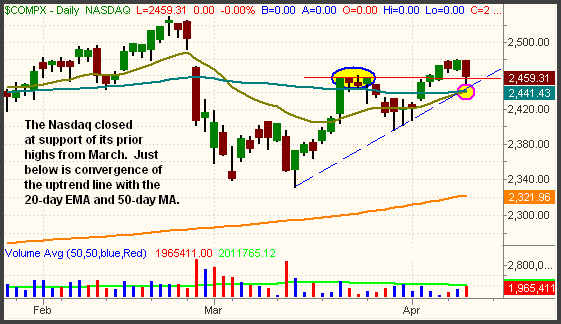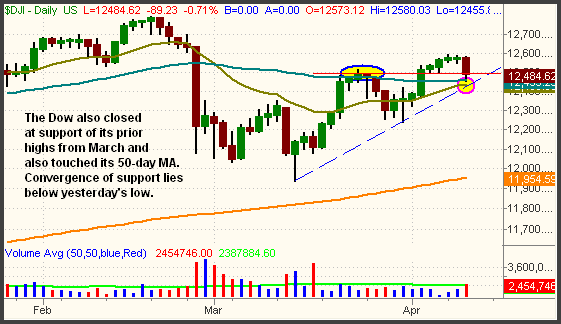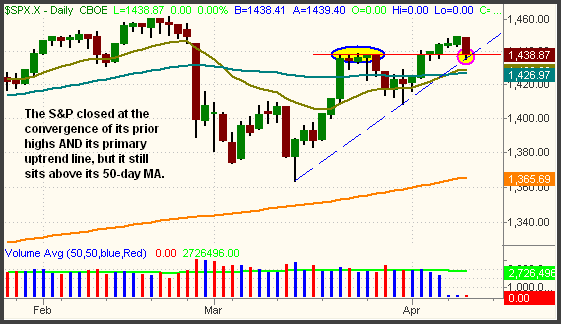|
The Wagner Daily ETF Report for April 12
Stocks snapped their recent winning streak yesterday, as the major indices sold-off firmly on increasing volume. After opening flat, the broad market trended steadily lower throughout the morning, retraced more than half of the losses at mid-day, then resumed the downtrend and broke down to new lows in the afternoon. The S&P 500, Nasdaq Composite, and Dow Jones Industrial Average each shed 0.7%. The small-cap Russell 2000 lost 0.8% and the S&P Midcap 400 fell 0.6%. A bounce in the final hour of trading lifted the major indices off their worst levels, but they each still finished in the bottom 25% of their respective intraday ranges.
Turnover rose across the board, causing both the S&P and Nasdaq to register bearish "distribution days." Total volume in the NYSE increased by 17%, while volume in the Nasdaq was 7% higher than the previous day's level. Negative market internals confirmed the losses. In both exchanges, declining volume exceeded advancing volume by a ratio of approximately 5 to 2. In the April 10 issue of The Wagner Daily, we said the following about the April 9 action in the Nasdaq, ". . . the day was indicative of "churning" that occurs when an index registers higher volume without a significant advance or decline in price. When this happens at the top of a range, it is a warning signal that often precedes institutional selling a day or two later." As anticipated, heavy selling by mutual funds, hedge funds, and other institutional traders occurred yesterday, two days after Monday's "churning."
Also in our April 10 commentary, we cautioned that "it only takes one day of institutional selling (aka "distribution day") to undo a week's worth of gains that occurred on declining volume." This is exactly what happened yesterday, except that "only" four days of gains in the S&P and Dow were wiped out. Obviously, yesterday's session was decisively bearish and reversed the short-term trends of the major market indexes from "up" to "down." However, the major indices have quite a bit of technical support below yesterday's closing prices that may make it difficult for them to go much lower without continued institutional selling pressure. First, take a look at the daily chart of the Nasdaq Composite:

The Nasdaq closed just above a multiple convergence of price support. As the chart illustrates, key support levels consist of: the primary uptrend line (the dashed blue line), the prior highs from March (the red horizontal line), and convergence of the 20-day EMA with the 50-day MA. Notice how the primary uptrend line also lines up with convergence of the 20-day EMA and 50-day MA. Yesterday's bearish action combined with the numerous levels of support could lead to a volatile tug-of-war between the bulls and bears, so be prepared for erratic and indecisive action over the next few days. The bulls may still be in control, but a firm close below the 2,441 level would tip the balance of power back to the bears.
The daily charts of both the S&P 500 and Dow Industrials are similar to the Nasdaq. Both indices finished just above support of their primary uptrend lines and near their prior highs from March. In both indexes, convergence of the 20-day EMA and 50-day MA lie just below. For the Dow, a close below 12,435 would likely lead to significant selling, while the S&P still has a way to go before breaking support of its 50-day MA (1,427). Below are annotated charts of both indices:


All three of our open positions are starting to look pretty good. The StreetTRACKS Gold Trust (GLD) continues to lazily grind its way higher, so we continue to trail a stop as well. Since our entry, it is showing a gain of approximately one point. We also remain short the iShares DJ Real Estate (IYR), which we pointed out a few days ago as having major relative weakness to the broad market. When an ETF is so weak that it only moves sideways while the major indices are rallying, it typically is suffers a significant loss when the broad market eventually pulls back. That is what happened to IYR, which fell 1.3% yesterday (nearly double the loss of the S&P 500). The short trade is taking longer to follow-through than originally anticipated, but the pattern remains bearish. Finally, we are long the ProShares Ultra Short Russell 2000 (TWM), which is inversely correlated to the price movement of the Russell 2000 Index, and at a ratio of 2 to 1. Though we only looked at charts of the S&P, Nasdaq, and Dow, the Russell has actually shown more relative weakness than all three of those indexes.
Deron Wagner is the Founder and Head Trader of both Morpheus Capital LP, a U.S. hedge fund, and Morpheus Trading Group, a trader education firm launched in 2001 that provides daily technical analysis of the leading ETFs and stocks. For a free trial to the full version of The Wagner Daily or to learn about Wagner's other services, visit MorpheusTrading.com or send an e-mail to deron@morpheustrading.com.
|